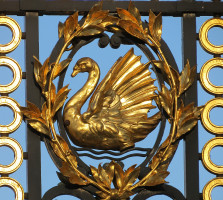
Victorian and Edwardian sculptures of swans are not rare, but not so common either. Cast iron swans seem a particular Victorian favourite. The beautiful gilt swan in cast iron at the top of the page is encircled with a wreath of laurel leaves, and both wreath and swan suggest kingliness, nobility, wealth.
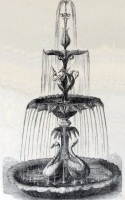
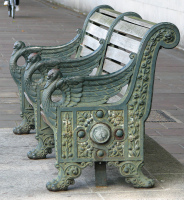 Mid-Victorian cast iron swan sculpture: fountain and bench.
Mid-Victorian cast iron swan sculpture: fountain and bench.
Above left is also typical, with statues of swans as part of an ornamental fountain. The swan in this context suggests grace, beauty and nobility, for historically swans belonged to the crown, and of course it is also a suitable bird for a watery ornament such as a fountain. This example has slender cormorants above, as if the birds were equivalent to orders of Classical pillars, with heavier Doric ones (the swans) below, and lighter Corinthian ones (the cormorants) above. To the right is an example of a swan bench, familiar to many Londoners from the Victoria Embankment, Albert Embankment and Chelsea Embankment.
Here are two swan sculptures in relief. The one on the left, like the gilt one in the gate at the top of the page, shown a swimming swan, with half-opened wing, graceful curved neck, and in this case, little waves on the water. The one on the right, a very slight relief sculpture, much painted and probably iron again underneath, is an example of a standing swan and upraised wings.
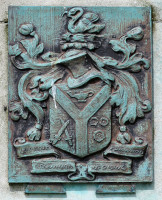
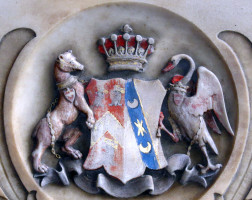 Coats of arms incorporating a swan.
Coats of arms incorporating a swan.
We can have swans in coats of arms, the example above incorporates a crude but recognisable swan in swimming pose, biting a snake (you will need to click to enlarge to see it properly). To the right is a delicately carved swan as a supporter in the arms of the Countess of Beauchamp, from her monument in St Marylebone Parish Church; the sculptor was C.R. Smith. Note the chained crown around the swan's neck.
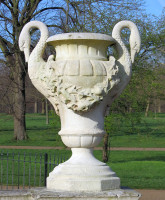
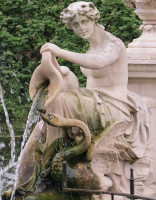 Swan sculpture in Kensington Gardens (Italian Water Gardens), by John Thomas.
Swan sculpture in Kensington Gardens (Italian Water Gardens), by John Thomas.
Above left is a large ornamental vessel with swan-necked handles. It is one of several in the Italian Water Gardens, London, hence appropriate as a water bird. It has a well defined scaly look to the neck. To the right, from the same location, is a girl pouring from a pot with decorative swan nosing at the pouring stream of water. The wings are raised in this case. The sculptor of both works was John Thomas.
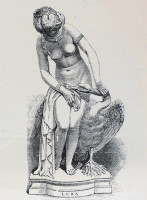 Leda and the Swan sculptural group.
Leda and the Swan sculptural group.
This girl and swan composition brings us to a common swan variant, which is Leda and the Swan. Leda, we may recall, was a queen from ancient Greek mythology who was visited by Zeus disguised as a swan, and was seduced by him. According to different versions of the story, out of her various offspring, some or all of Helen (of Troy), Clytemnestra (later Agamemnonís queen) and the Dioscouri Castor and Pollux (who were among the Argonauts) were the offspring of Zeus rather than Ledaís husband, who was Tyndareus, the King of Sparta.
By convention in Victorian sculptural groups of Leda and the Swan, Leda is nude, and the swan has its wings open or clasped in an embrace with her. Victorian statues of Leda and the Swan can be chaste, with an affectionate girl stroking a swan, as in the case above, which is a Staffordshire Parian ware group, or more sensual as in the two cases below: left is Derwent Woodís group, where Leda clasps the swan to her, and below right is S. Nicholson Babbís statue where the swan nibbles at Ledaís shoulder, the pose being rather similar to a Continental Leda group by Jules Desbois of a few years earlier.
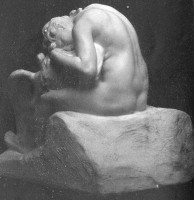
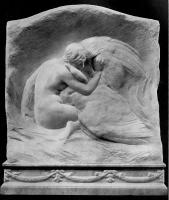 Leda and the Swan groups by Derwent Wood and S. Nicholson Babb.
Leda and the Swan groups by Derwent Wood and S. Nicholson Babb.
There are modern sculptures of swans, including one in the City of London shown at the bottom of the St James Garlickhythe page. However, I wanted to end this page with another modern example of a sculpture of an angry swan, standing by the water, crudely inscribed and roughly finished, but nevertheless epitomising the essence of a swan in foul mood.
Examples of swans in earlier sculpture are scattered through these pages; a couple of rather early ones associated with the coat of arms for Lord Hunsdon (Sir John Cary) can be seen on the page on Hunsdon Church, Herts.
Visits to this page from 6 Sept 2014: 7,648
Eagle statues // Owl statues // Other animal sculpture // Allegorical sculpture